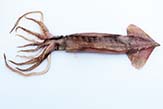Meats and Sausages
Squid
Shellfish RecipesSquid, Protein-15.58%, Fat-1.38%, Water-78.55%
Biologically, squid belong to the class of mollusks known as cephalopods, which also include octopus. Squid found along Washington’s coast, the Strait of Juan de Fuca and Puget Sound are called Pacific squid, opalescent, or-most commonly-market squid (Loligo opalescens). Adult market squid found in inside waters average about eight inches (mantle plus tentacles). The Humboldt species of squid is usually found off the coasts of central and South America but has extended its range to the north, mainly during the late summer and early fall months when the water temperatures are at their highest.
Smoked Squid (Adapted from Tanikawa, 1985, Marine Products in Japan).
Remove head, viscera and tendons from body. Cut off fins. Wash with freshwater. Soak fish for 10-20 min in hot water 122-131° F (50-55° C), with agitation, to remove skin. Wash and boil at 176-194° F (80-90° C) for 2-3 minutes. For 3.75 kg (8.25 lb) boiled squid, mix 200-250 g salt, 750-940 g sugar. 37 g sodium glutamate, and 3.7 g sodium 5-ribonucleotide. Season by sprinkling with seasoning materials, pile in 2-3 layers on a table, and apply light pressure on the squid. Hang the squid in smokehouse and smoke at 68-77° F (20-25° C) for the first 1-2 hours, at 122-140° F (50-60° C) for 4 hours, and at 140-158° F (60-70° C) for the final 2-3 hours. Cut smoked squid into rings, 1-2 mm wide. Mix 357 g sugar, 100-110 g salt, 3.7 g sodium glutamate, 0.4 g sodium 5-ribonucleotide, and 500 ml water and sprinkle on smoked squid. Dry the surfaces in a dryer.


















